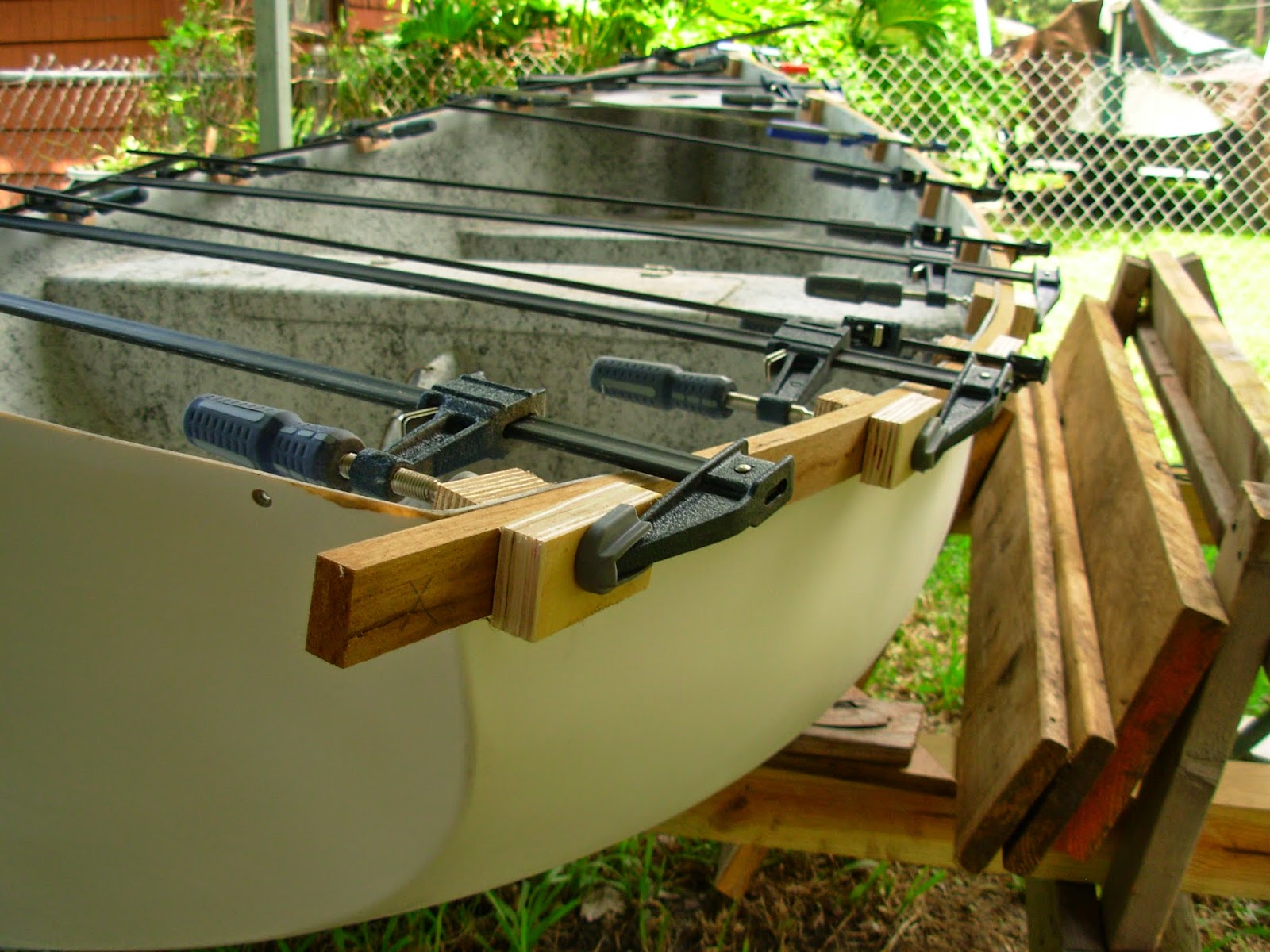Saturday, August 9th, I set out to begin the dry-fitting of the rails - at least the outboard rails. I started out by selecting two of the four rough-prepared teak rails, and then cut those two pieces to a more manageable size.
At the boat, I oriented the rails fore and aft, starboard and port, and placing the most pleasing grain to the outside for visual appeal.
While I was orienting the rails to their future homes, I fired up the steam box...
...and first placed the port rail inside. You can just barely make out wisps of steam emanating from the "box"; the rails would stay in the steam box for roughly 45 minutes.
While the port teak rail was "softening" in the sauna, I finished preparing for the bending and clamping of the rails. Using a hot glue gun, I applied small clamping blocks to the inside sheer of the boat - along both the port and starboard sides.
I also prepared small clamping blocks for the rail itself. These blocks would serve to protect the soft wood from the clamps, helping to distribute the clamping force across a broader surface and helping to eliminate marring the teak rails. Finally, I positioned 9 clamps along the port side and 9 clamps along the starboard side. The stage was set.
Still having time before the teak was ready to emerge from the steam box, I decided to make final decisions on the fasteners for both the rails and the thwarts. For the outboard rails, I decided to use a #6 1 1/4" stainless steel wood screw and a finish washer. This screw will ultimately pass through the inboard rail, through the fiberglass of the boat's sheer, and into the outboard rail. The length is just a tad long, so I will plan on snipping just a "touch" off the end to ensure damage-free installation. The inboard rails will be secured first, and will be set in place with silicon bronze #8 3/4" wood screws. Again, these screws will require just a bit of length removed to ensure a good fit. In addition, these bronze screw heads will be recessed into the outboard sheer of the boat to allow the outboard rail to be installed over them, thereby hiding them from view.
The thwarts will be secured with a combination of #8 silicon bronze screws, two 1 1/4" screws, one 1" and one 3/4" screw. These screws will also be recessed into the sheer and hidden from view by the outboard rail. I haven't fully settled on the use of #8s, and so may move up to #10s for the thwarts.
Having made most of the fastener decisions, I was ready to pull the port teak rail from the steam box. Wearing heavy gloves, I pulled the water-soaked towel away from the steam box opening and grabbed the port rail. Beginning at the stern, I set the rail against the sheer, placed the lose block against the rail, and set the clamp in place. I then set the clamp to firm pressure, and then moved forward to the next station, or glue block. I continued down the port side, bending the rail in and clamping as I went.
The picture below shows the port outboard rail "bent on" the outboard sheer. I then returned to the steam box and placed the starboard rail inside. After 45 minutes, I was ready to repeat the exercise.
Looking over the bow, both rails are clamped into place.
Finally, a shot of the starboard aft quarter. The rails will set up over the next few days, taking on the shape of the boat's sheer. The inboard rails will be next, and I will use the same technique. Just prior to the bending of the inboard rails, I will plan to make final adjustments to the thwarts and dry-fit them with fasteners. Having them in place will allow me to make the necessary final length adjustments to the inboard rails.
Total Time: 3 Hrs.












No comments:
Post a Comment